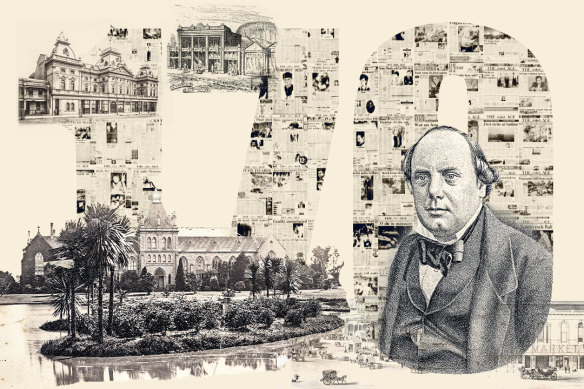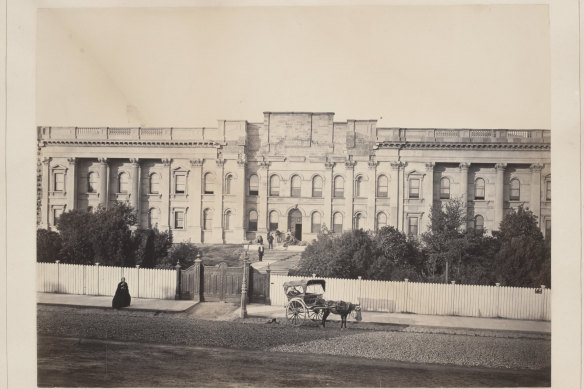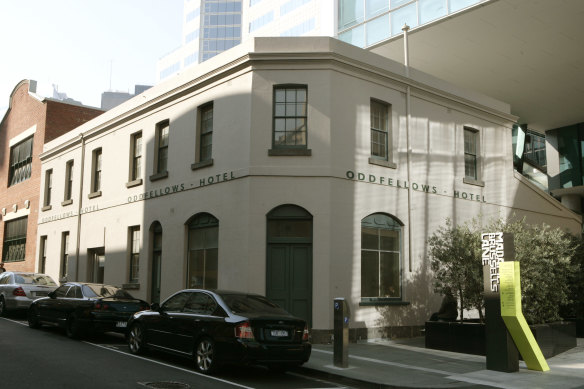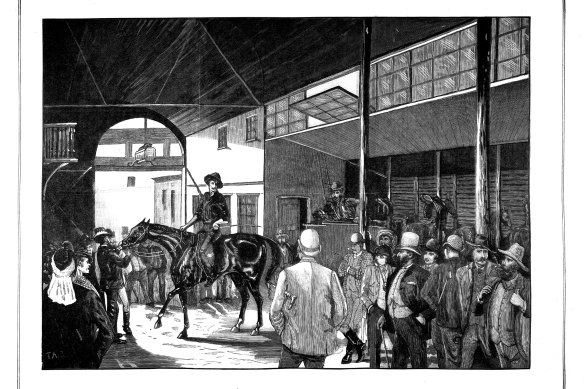This was published 3 months ago
Equestrian shows and Shakespeare in a tent: A Saturday night in Melbourne in 1854
You might have a drink at the tavern, or take in a circus show of dance and swordplay on horseback. As The Age celebrates 170 years, we look back at the city’s cultural life in 1854.
By Karl Quinn

Actor-turned-impresario George Coppin (right) was a key figure in Melbourne’s rich cultural life in 1854.Credit: Marija Ercegovac
If you were suddenly transported through time to a Saturday night in Melbourne in 1854, you would find yourself in a city at once familiar and strange. With a few exceptions, the buildings would look rather less robust than today’s structures, many of them timber and canvas, little more than oversized tents. But the degree to which the city is a playground come nightfall would strike an immediate chord.
You’d recognise what we now call the CBD from the grid layout, even if some of the street names were unfamiliar and there were more laneways to wander down – and get lost, loose, and perhaps looted in – than there are today.
But only a few of the grand public buildings would be recognisable. The State Library of Victoria (SLV) was newly established, and building towards a grand ambition of becoming a facility the equal of “any provincial town in Great Britain”, with 20,000 books on its shelves.

The State Library of Victoria photographed in 1864, when it was known as the Melbourne Public Library.Credit: State Library of Victoria
“If money can purchase it, we should have it,” The Age wrote on February 12, 1856. “Otherwise, we shall always be suffering the evils of an intellectual famine, and no man can compute what they may cost a community.”
Today’s SLV is home to more than 2 million books.
Where today’s Kmart Centre stands, on Bourke Street, you’d find a massive building under construction. In just a few months – on January 1, 1855 – the Theatre Royal will open, with Richard Sheridan’s 18th-century comedy The School for Scandal its first presentation.
Run by actor-turned-impresario George Coppin, The Royal accommodates 3300 people over its four levels and costs a colossal £60,000 to build. John Black, who made his fortune as a carrier on the goldfields, will soon lose it all on this magnificent folly.
Taverns, music halls, brothels ...
Heading up the hill towards Spring Street, you might do a double-take outside the four-shop terrace between Romeo and Juliet lanes (now Crossley and Liverpool); you might recall this as Job Warehouse (though it’s sadly now vacant), and wonder at the fact a chap called Crossley was running a butcher shop there in 1854.
Heading north, you might pass the Oddfellows Hotel (still standing) on Little Lonsdale Street, en route to a grand bluestone building colloquially known as Wintle’s Hotel. But, like any upstanding citizen of the time, you’d pray you would have no more than a passing acquaintance with the Melbourne Gaol (George Wintle was its first warden).

The Oddfellows Hotel photographed in 2008.Credit: Eddie Jim
On this Saturday evening, you’d almost certainly be luxuriating in the fact your working week was a couple of hours behind you. As a working man, your pocket would be jangling with change (as a working woman, you’d have no pockets), and the lure of the east end would be hard to resist.
Taverns, music halls, circuses, brothels, street food and roadside “scientific” demonstrations (have your skull examined by a phrenologist, and your character read from its bumps) – all would clamour for your attention well into the small hours.
Even the shops would be open until midnight. Officially, Sunday is a day of rest, everything closed, but if you’re in the know you’ll be able to locate a sly grog shop to kick on tomorrow, should that be your fancy. Come Monday, the 5½-day working week will resume … unless you’re a little, ahem, unwell. In which case, see you next Tuesday, boss.
Little Lon will soon become notorious as the epicentre of Melbourne’s seediest activities, but in 1854 much of that still centres on Little Bourke and its tributaries, all within a quick stroll of Spring Street. A stroll up here is replete with all manner of temptations, but beware – many an amorous advance has ended with a fellow being relieved of his wallet or his watch, the latter to be fenced at a nearby market before the minute hand has done a full circuit of the dial.
The clamour to stamp out all this licentiousness will rise in step with the new Parliament House, which opens in 1856. But the fact that many of the premises on which the drinking, gambling, prostitution and thievery take place belong to honourable members of the new British colony rather undercuts all that high-blown posturing.
A time for theatres and circuses
Not all activities up this end of town are quite so dubious, though. Spurred by the discovery of gold in 1851, Victoria is on a fast track to reposition itself not just as a place of bountiful diggings, but also of cultural riches. As historian Frank Van Straten writes: “In just four frantic years between 1852 and 1856, six new theatres – and a couple of circuses – opened in the East End of town, while the more sombre surroundings of the Temperance Hall in Russell Street and the Athenaeum Hall in Collins Street hosted concerts and educational lectures.”
Looking rather like the Spiegeltents that emerged many decades later, the Salle de Valentino (now the site of the Imperial Hotel), which opened on the corner of Bourke and Spring streets in 1852, is “a circular building, half barn, half tent”. Inside, the entertainment on offer might include minstrel troupes, dances, concerts. Its crowd is rough, described by some sneering locals as comprising “prostitutes and other bad characters”.
At the top of the hill, where the Princess Theatre (built in 1886) now sits, Astley’s Amphitheatre is, in the words of Van Straten, “a big, barn-like brick and iron-roofed structure with a central ring as well as a stage for drama”. You might see an equestrian show here. You might just as easily stumble upon Shakespeare.
Be quick, though: in 1857 the 2000-capacity venue is refurbished – “at a cost of several thousand pounds”, writes The Age that year – and relaunched as the Princess’s Theatre and Opera House. A season ticket in the dress circle (the posh seats) will set you back £6/6s for 24 shows. You can stand downstairs for £4/4s, though you might pass out from the heat. “So far as we could observe no other ventilation is provided than the perforated centrepiece in the roof, consequently the heat became insufferable,” The Age fulminated. “This must be remedied.”
Melbourne’s newfound wealth is drawing performers from England and Europe, and to a lesser extent the US, and it’s possible to find ballet, opera, theatre, classical music, bawdy comedy – pretty much every manner of entertainment yet devised – in some corner of this booming city. There are dances, some formal, many less so.
The Royal Melbourne Philharmonic Society, founded a year earlier and still going today, offers choral singing and concerts. At the Hall of Arts on Collins Street, members of the Mechanics Institute can make use of a reading room, library and museum, and take part in music and drawing classes and evening lectures. Though the original 1842 building will give way to a rebuild in 1886, the institute – which will be renamed the Melbourne Athenaeum in 1872 – is still going strong today.
On the corner of Lonsdale and Stephen (now Exhibition) streets stands Rowe’s American Circus, where Californian imports Eliza and Joseph Rowe present “truly graceful acts of equestrianism” that combine “dance, acrobatics and feats of swordplay – all on horseback”. “Dressed in a calf-length skirt and culottes,” writes historian Robyn Annear in her 2023 book Corners of Melbourne, Eliza would “hold balletic poses or leap through hoops while her steed, the pony Mercury, galloped round the circus ring”.
The city can’t get enough of horse-related entertainment. At the western end – on the other side of the flood-prone chain of ponds that dominate Elizabeth Street – people congregate around the “horse bazaars” of Bourke Street, between Elizabeth and Queen streets. Horse racing has been a part of the city’s culture since the beginning – the first organised event was staged in 1838 – but for those too impecunious (or wise) to wager, there’s endless fun to be had simply watching the horses being broken in or auctioned.

Kirk’s Bazaar, at the site of today’s Hardware Lane, was established in 1840 and became the city’s best-known horse bazaar. Wood engraving by Alfred Martin Ebsworth, published in the Australasian Sketcher.Credit: State Library of Victoria
For those of an Empire mindset, the newly erected Crystal Palace on William Street (later site of the Royal Mint) showcases the wares of the colonies: including the first edition of The Age, which was published in the temporary exhibition building on October 17, 1854. It’s mighty crowded, though; in just a month, 40,000 people will pass through, more than half the city’s population. The building is long gone, but the crush of the crowd, and the rush of excitement that comes from knowing you’re in a city teeming with culture, will be familiar to anyone who’s ever stepped out on the streets of modern Melbourne during the comedy, arts, film or food festivals, or indeed when a Taylor Swift or Oasis tour comes to town.
For all that has changed in Melbourne in the past 170 years, one thing remains the same: the city is still our favourite playground.
Start the day with a summary of the day’s most important and interesting stories, analysis and insights. Sign up for our Morning Edition newsletter.